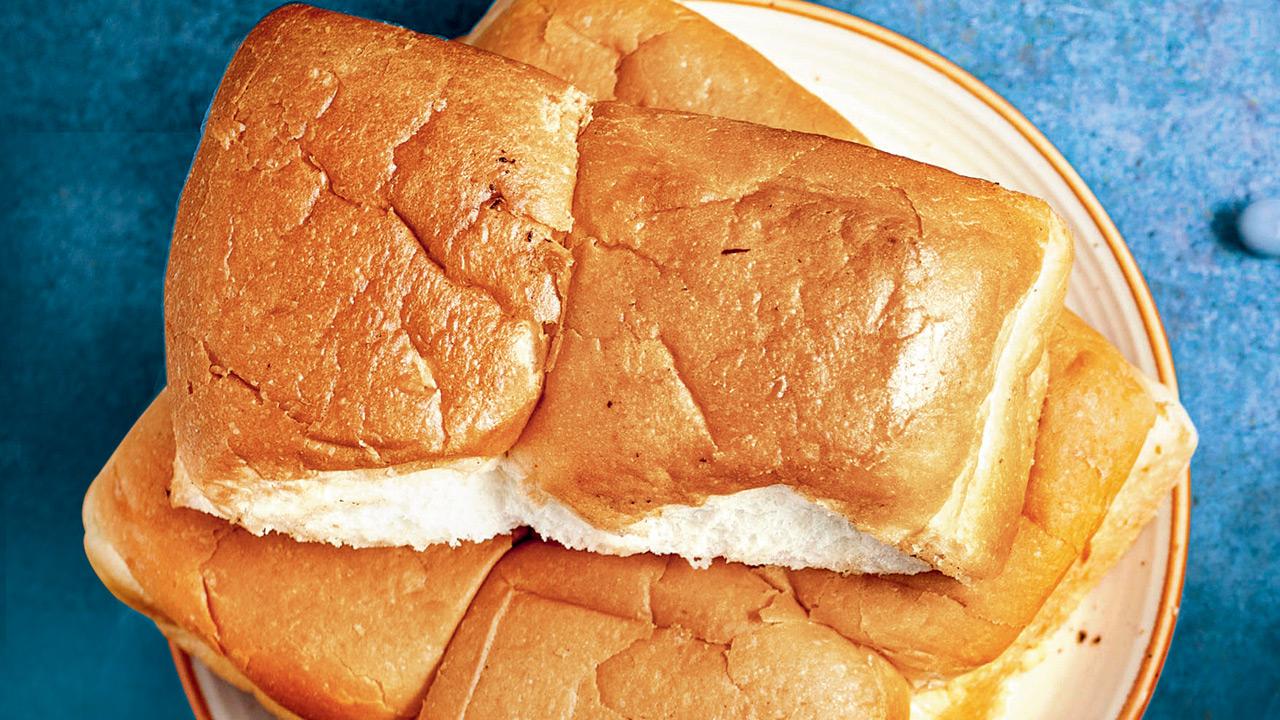As it shifts from brick ovens to electric versions—the pav will be more eco-friendly. But experts say the flavour of Ladi pav depends on the unique alchemy of flour, water, Tower yeast and wood-fired ovens. Will Mumbai adapt to this new taste?

Pav-making at Shahpur Bakery, which has a wood-fired oven, in Tardeo. Pic/Shadab Khan
A familiar part of Mumbai’s landscape—the city’s traditional brick ovens and towering chimneys that have long been at the heart of its bakery culture—is on the brink of change. With the BMC setting a deadline of July 7 for bakeries to switch to eco-friendly electric, LNG, or LPG-fired ovens, the fate of the city’s beloved laadi pav, baked in wood-fired ovens for generations, hangs in the balance.
ADVERTISEMENT

Next to the Sardar Pav Bhaji in Tardeo sits the renowned Shahpur bakery, a hidden gem known for its irresistibly fresh pav and perfectly crisp brun. Local women would craft delicate nankhatais at home and bring them here to be baked—infusing the air with tradition, community, and time-honoured craftsmanship. Pic/Shadab Khan
“The laadi pav, a Portuguese innovation, was introduced to Mumbai by the Catholic pavwallas of Goa between the 1820s and 1870s, eventually becoming a citywide staple,” shares Dr Kurush F Dalal, archaeologist and culinary anthropologist, “Around the same time, Muslim bread makers and Zoroastrian Irani bakers, with their deep-rooted baking traditions, also contributed to its spread.”
“Pav quickly gained popularity among Mumbai’s working class, especially mill workers living in shared accommodations, where hot, fresh chapatis weren’t a viable option,” explains the food historian, “Pav was affordable, had better shelf stability than roti, and provided a quick, fuss-free meal when paired with bhaji [not to be confused with today’s pav bhaji]. Unlike roti, pav was egalitarian—everyone ate the same bread, breaking social barriers while easing the burden of home cooking, particularly for women.”

The pav is ubiquitous to Mumbai. From vada pav stalls at railway stations, to omelette pav and pav bhaji handcarts near bars, this pillowy bread can be found in every corner of the city—a ready snack for Mumbaikars on the go. File pic
Iconic street foods like vada pav, misal pav, and pav bhaji—where pav is the real hero—came much later. Like all of us, Dalal too will miss the wood-fired pav, but he thinks it’s time for us to move on and modernise. The move to electric and gas-powered ovens does promise cleaner air and modernised operations, after all.
“As Mumbai grows taller, towering chimneys are no longer feasible. Once built from brick, and then metal, they simply can’t stretch to 25 or 45 stories,” he points out, “The real issue isn’t losing the wood-fired flavour—that can be replicated—but the staggering cost of transition. Entire setups must be dismantled, new proofers installed, and expensive electric or gas ovens brought in. With gas prices soaring and electricity costs set to double, how many bakeries can afford the shift? The bigger question is—will pav, the ultimate commoner’s bread, remain affordable?”
Chef and restaurateur Yajush Malik acknowledges the cost advantages of industrial production. But this economic war of scale versus artisanal operations has forced many local pav wallas to shut shop, after they were unable to compete.

Heena Punwani pulls out a steaming batch of pavs from the electric oven at Maska Bakery, Mahim. Pic/SAYYED SAMEER ABEDI
And yet, pav has been inseparable from Mumbai for nearly a century, adapting to the city’s ever-changing landscape. “Mumbai’s laadi pav is unlike any other—a high-hydration dough, well-kneaded, long-proofed, and often wood-fired for a smoky crust. Pav made outside Mumbai is often just white bread shaped like pav. Ours has a unique pillowy texture with a slight chew, perfect for soaking up flavours without overpowering them,” he explains.
Despite the rise of artisanal and gluten-free bread, Malik doesn’t see laadi pav fading. “The OG artisanal bread has a universal appeal. While some bakeries use industrial shortcuts, the true custodians of Mumbai pav still stick to tradition,” he adds.
For decades, laadi pav has seen no innovation. Its signature taste, we are told, comes from one brand of yeast, Tower, which is used in almost every bakery in the city, thanks to its affordability. “Shaped by bulk fermentation, heat, humidity, and Tower yeast—it’s a combination that ensures that pav across Mumbai tastes nearly identical and is nearly impossible to replicate outside the city. It’s more than just bread—it’s part of the city’s soul,” shares Dalal.

Mumbai’s humid weather accelerates fermentation, giving pav its signature slight sourness, says Pinky Chandan-Dixit, Founder at Aamchee. “When we mass produce or mechanise it, we stabilise the process to make it more uniform and predictable,” she says, “Sadly, we will see the end of the wood-fired oven era, and the smaller family establishments will be most affected. I hope they modify this rule to benefit all.”
“Pav is the backbone of Irani café culture, a symbol of simplicity, affordability, and togetherness,” says Mansoor Showghi Yezdi, a veteran of Mumbai’s café scene and founder of Cafe Irani Chai. “Whether it’s served with kheema, slathered with maska and dipped in chai, or paired with a rich akuri, pav is more than just bread—it’s a tradition. But more than food, pav represents the spirit of these spaces, where students, office-goers, and old-timers sit shoulder to shoulder, sharing a table, a conversation, and a warm, fresh pav.”
Heena Punwani, Pastry Chef and Founder of Maska Bakery in Mahim, says, “Pav isn’t just bread; it’s the great equaliser of Bombay. No matter who you are or where you come from, everyone loves it.” At Maska, Punwani enriches her pav with milk and butter, giving it a softer, more indulgent texture—something large-scale commercial bakeries simply can’t replicate. “Mass-produced pav, wrapped in plastic with a long shelf life and available on Swiggy or Zomato, tastes nothing like the artisanal loaves from your neighbourhood bakery,” she says.

In Mahim, for instance, Bimbo Bakery still bakes pav the old-school way, producing two fresh batches daily. “They make these incredible bada pav, essentially a larger version of the classic. If you’re late, they’re gone! You literally have to ask them to save some for you,” says Punwani.
Now this very legacy is under threat. “The charm of traditional wood-fired bakeries lies in their flavour—something industrial ovens simply can’t replicate,” says Punwani. “These bakeries have kept pav affordable precisely because they still use wood-fired ovens. If they are forced to switch to industrial ovens, how will they bear the cost? Will pav still remain a staple?”
She points out the irony: “Around the world, countries take pride in their artisans, boasting about wood-fired pizzas and bread. But here in Mumbai, where humble, unsung bakers have been quietly keeping this tradition alive, we may soon see them disappear.” Dalal echoes the concern—while the government has issued an ultimatum, where’s the support for bakeries to make the switch? Most of these establishments operate on razor-thin margins, prioritising affordability over profit.
Bakeries are facing skyrocketing fuel costs—one 19 kg LPG cylinder now costs over Rs 2,000. Commercial gas storage is a logistical nightmare, and piped gas isn’t reliable at the pressure required for baking. That leaves electricity. But a single power cut mid-bake could ruin an entire batch, making backup generators a necessity—something only large commercial bakeries can afford. As for small, family-run bakeries? Without real financial and logistical support, they won’t stand a chance.
The bakers’ perspective
India Bakers Association President Khodadad P Irani lays out the harsh reality: “The traditional dome-shaped brick ovens still used in many bakeries today—spanning 120-180 sq ft—are built exclusively for firewood. They have no temperature control, making a switch to electricity nearly impossible, both physically and economically. The power required to heat such a large surface would be astronomical.”

Khodadad Irani
LPG is even riskier, he says. Bakeries, often housed in residential buildings or crowded areas, would need to store at least 20 cylinders at a time. With bakery temperatures soaring to 40-45°C, this is a disaster waiting to happen. Most areas don’t have the infrastructure for piped gas, and setting it up is prohibitively expensive.
The only solution? “Tearing down old ovens, dismantling tall chimneys, and rebuilding entire structures from scratch,” he laments. “We’re not against change,” Irani clarifies, “But it has to be practical. We urge authorities to extend the deadline to at least 30-36 months and offer subsidies covering 75 per cent of the cost. Why not allow high-speed diesel in the interim? Bread is a daily essential—we must find a solution that works for everyone.”
Pav maane feet?
It is said that back in the day, the dough was kneaded by foot. “We were told that’s why they call it ‘pav’ (paon in Hindi),” laughs Pinky Chandan-Dixit, Founder at Aamchee. archaeologist and culinary anthropologist Dr Kurush F Dalal recalls his grandfather turning him off pav with similar tales. “He’d say that if you find black specks on your pav, that’s dirt from the toes of people kneading it. “I was grossed out. Now everybody has a kneading machine,” he adds.
 Subscribe today by clicking the link and stay updated with the latest news!" Click here!
Subscribe today by clicking the link and stay updated with the latest news!" Click here!







